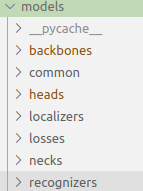目录
GradCam可视化ResNet50范例
import argparse
import cv2
import numpy as np
import torch
from torch.autograd import Function
from torchvision import models
class FeatureExtractor():
""" Class for extracting activations and
registering gradients from targetted intermediate layers """
def __init__(self, model, target_layers):
self.model = model
self.target_layers = target_layers
self.gradients = []
def save_gradient(self, grad):
self.gradients.append(grad)
def __call__(self, x):
outputs = []
self.gradients = []
for name, module in self.model._modules.items(): ##遍历目标层的每一个模块,比如卷积、BN,ReLU
x = module(x)
if name in self.target_layers:
x.register_hook(self.save_gradient) #利用hook来记录目标层的梯度
outputs += [x]
return outputs, x #output保留目标层的所有模块的特征输出
'''
根据模型结构以及模型的预训练参数,依次对输入图像进行每一个网络层的处理
'''
class ModelOutputs():
""" Class for making a forward pass, and getting:
1. The network output.
2. Activations from intermeddiate targetted layers.
3. Gradients from intermeddiate targetted layers. """
def __init__(self, model, feature_module, target_layers):
self.model = model
self.feature_module = feature_module
self.feature_extractor = FeatureExtractor(self.feature_module, target_layers)
def get_gradients(self):
return self.feature_extractor.gradients
def __call__(self, x):
target_activations = []
for name, module in self.model._modules.items():
if module == self.feature_module:
target_activations, x = self.feature_extractor(x)
'''
当到达指定输出的网络层时,输出该层的激活特征值并保留该层的输出
'''
elif "avgpool" in name.lower():
x = module(x)
x = x.view(x.size(0),-1)
else:
x = module(x)
return target_activations, x
'''
x表示对模型最终分类层的输出
'''
def preprocess_image(img):
means = [0.485, 0.456, 0.406]
stds = [0.229, 0.224, 0.225]
preprocessed_img = img.copy()[:, :, ::-1]
for i in range(3):
preprocessed_img[:, :, i] = preprocessed_img[:, :, i] - means[i]
preprocessed_img[:, :, i] = preprocessed_img[:, :, i] / stds[i]
preprocessed_img = \
np.ascontiguousarray(np.transpose(preprocessed_img, (2, 0, 1)))
#transpose HWC > CHW
preprocessed_img = torch.from_numpy(preprocessed_img)
preprocessed_img.unsqueeze_(0)
input = preprocessed_img.requires_grad_(True)
return input
def show_cam_on_image(img, mask):
heatmap = cv2.applyColorMap(np.uint8(255 * mask), cv2.COLORMAP_JET)
heatmap = np.float32(heatmap) / 255
cam = heatmap + np.float32(img)
cam = cam / np.max(cam)
cv2.imwrite("cam.jpg", np.uint8(255 * cam))
class GradCam:
def __init__(self, model, feature_module, target_layer_names, use_cuda):
self.model = model
self.feature_module = feature_module
self.model.eval()
self.cuda = use_cuda
if self.cuda:
self.model = model.cuda()
self.extractor = ModelOutputs(self.model, self.feature_module, target_layer_names)
def forward(self, input):
return self.model(input)
def __call__(self, input, index=None):
if self.cuda:
features, output = self.extractor(input.cuda())
else:
features, output = self.extractor(input)
if index == None:
index = np.argmax(output.cpu().data.numpy())
'''
得到模型最后一层输出特征的分类概率,根据输出的概率的大小判断它与输入图片中哪些区域的像素值更敏感
'''
one_hot = np.zeros((1, output.size()[-1]), dtype=np.float32)
one_hot[0][index] = 1
one_hot = torch.from_numpy(one_hot).requires_grad_(True)
if self.cuda:
one_hot = torch.sum(one_hot.cuda() * output)
else:
one_hot = torch.sum(one_hot * output)
self.feature_module.zero_grad() #梯度清零
self.model.zero_grad()
one_hot.backward(retain_graph=True) #反向传播取得目标层梯度
grads_val = self.extractor.get_gradients()[-1].cpu().data.numpy()
#调用函数get_gradients(), 得到目标层求得的梯度(目标层特征图的每个像素的偏导数)
'''
'''
target = features[-1]#feature 包含卷积、BN、和ReLU层,这里取ReLU作为最后的特征值
target = target.cpu().data.numpy()[0, :]
#忽略Batch数目,只取C,H,W维度
print(target.shape)
#特征图每个像素的偏导数求出来之后,取一次宽高维度上的全局平均,得到c类相对于该卷积层输出特征图的第k个通道的敏感程度 weifhts.shape=[n,c]
weights = np.mean(grads_val, axis=(2, 3))[0, :]
print(weights.shape)
cam = np.zeros(target.shape[1:], dtype=np.float32)
#target[i, :, :] = array:shape(H, W)累加各个通道的特征值
for i, w in enumerate(weights):
cam += w * target[i, :, :]
cam = np.maximum(cam, 0)
print(cam.shape)
cam = cv2.resize(cam, input.shape[2:])
cam = cam - np.min(cam)
cam = cam / np.max(cam)
return cam
class GuidedBackpropReLU(Function):
@staticmethod
def forward(self, input):
positive_mask = (input > 0).type_as(input)
output = torch.addcmul(torch.zeros(input.size()).type_as(input), input, positive_mask)
self.save_for_backward(input, output)
return output
@staticmethod
def backward(self, grad_output):
input, output = self.saved_tensors
grad_input = None
positive_mask_1 = (input > 0).type_as(grad_output)
positive_mask_2 = (grad_output > 0).type_as(grad_output)
grad_input = torch.addcmul(torch.zeros(input.size()).type_as(input),
torch.addcmul(torch.zeros(input.size()).type_as(input), grad_output,
positive_mask_1), positive_mask_2)
return grad_input
class GuidedBackpropReLUModel:
def __init__(self, model, use_cuda):
self.model = model
self.model.eval()
self.cuda = use_cuda
if self.cuda:
self.model = model.cuda()
def recursive_relu_apply(module_top):
for idx, module in module_top._modules.items():
recursive_relu_apply(module)
if module.__class__.__name__ == 'ReLU':
module_top._modules[idx] = GuidedBackpropReLU.apply
# replace ReLU with GuidedBackpropReLU
recursive_relu_apply(self.model)
def forward(self, input):
return self.model(input)
def __call__(self, input, index=None):
if self.cuda:
output = self.forward(input.cuda())
else:
output = self.forward(input)
if index == None:
index = np.argmax(output.cpu().data.numpy())
one_hot = np.zeros((1, output.size()[-1]), dtype=np.float32)
one_hot[0][index] = 1
one_hot = torch.from_numpy(one_hot).requires_grad_(True)
if self.cuda:
one_hot = torch.sum(one_hot.cuda() * output)
else:
one_hot = torch.sum(one_hot * output)
# self.model.features.zero_grad()
# self.model.classifier.zero_grad()
one_hot.backward(retain_graph=True)
output = input.grad.cpu().data.numpy()
output = output[0, :, :, :]
return output
def get_args():
parser = argparse.ArgumentParser()
parser.add_argument('--use-cuda', action='store_true', default=False,
help='Use NVIDIA GPU acceleration')
parser.add_argument('--image-path', type=str, default='.../mmaction2/data/ucf101/rawframes1/Typing/v_Typing_g11_c01/img_00001.jpg',
help='Input image path')
args = parser.parse_args()
args.use_cuda = args.use_cuda and torch.cuda.is_available()
if args.use_cuda:
print("Using GPU for acceleration")
else:
print("Using CPU for computation")
return args
def deprocess_image(img):
""" see https://github.com/jacobgil/keras-grad-cam/blob/master/grad-cam.py#L65 """
img = img - np.mean(img)
img = img / (np.std(img) + 1e-5)
img = img * 0.1
img = img + 0.5
img = np.clip(img, 0, 1)
return np.uint8(img*255)
if __name__ == '__main__':
""" python grad_cam.py <path_to_image>
1. Loads an image with opencv.
2. Preprocesses it for VGG19 and converts to a pytorch variable.
3. Makes a forward pass to find the category index with the highest score,
and computes intermediate activations.
Makes the visualization. """
args = get_args()
# Can work with any model, but it assumes that the model has a
# feature method, and a classifier method,
# as in the VGG models in torchvision.
'''
加载模型及模型的预训练参数
'''
model = models.resnet50(pretrained=True)
'''
指定可视化的卷积层,及卷积层中哪个模块的输出
'''
grad_cam = GradCam(model=model, feature_module=model.layer4, \
target_layer_names=["2"], use_cuda=args.use_cuda)
'''
读取图片归一化为[0,1]矩阵,并转换为张量形式
'''
img = cv2.imread(args.image_path, 1)
img = np.float32(cv2.resize(img, (224, 224))) / 255
input = preprocess_image(img)
# If None, returns the map for the highest scoring category.
# Otherwise, targets the requested index.
target_index = None
mask = grad_cam(input, target_index) #输出该张图像在指定网络层上,所有卷积通道的特征图叠加后的mask,用于后续和图片的叠加显示
show_cam_on_image(img, mask)
gb_model = GuidedBackpropReLUModel(model=model, use_cuda=args.use_cuda)
print(model._modules.items())
gb = gb_model(input, index=target_index)
gb = gb.transpose((1, 2, 0))
cam_mask = cv2.merge([mask, mask, mask])
cam_gb = deprocess_image(cam_mask*gb)
gb = deprocess_image(gb)
cv2.imwrite('gb.jpg', gb)
cv2.imwrite('cam_gb.jpg', cam_gb)GradCam可视化自定义的网络结构
- gradCam可视化自己模型的重点在于,完整加载模型,即加载自己的模型结构与预训练参数
在pytorch中,假设定义了模型
class MyModel(Module):pytorch中加载模型的方式:
#确定模型结构
model = MyModel()
# 加载参数
checkpoint = torch.load(PATH)
# 应用到网络结构中
model.load_state_dict(checkpoint['model_state_dict'])
不同项目工程集成了自己加载模型的方式
open-mmlab
- 将每个模型分为了不同的模块

- 可以直接通过config文件设置网络结构与预训练模型的加载(预训练模型也可以单独设置手动加载)
config='./configs/recognition/i3d/i3d_r50_32x2x1_75e_ucf101.py'
cfg = mmcv.Config.fromfile(config) #调用mmcv库解析加载模型结构
model=build_recognizer(
cfg.model, train_cfg=cfg.train_cfg, test_cfg=cfg.test_cfg)打印看看,此时识别器的模块只有两个,
for name, child in model._modules.items():
print(name)backbone
cls_head
我们需要分析的一般是backbone中的特征层,继续打印看看
for name, child in model.backbone._modules.items():
print(name)conv1
maxpool
pool2
layer1
layer2
layer3
layer4
调用mmcv库,加载模型预训练参数
load_checkpoint(model,'./checkpoints/i3d/##.pth')初始化GradCAM,指定想要可视化的模型及网络层
grad_cam = GradCam(model=model,feature_module=model.backbone.layer4, \
target_layer_names=["2"], use_cuda=args.use_cuda)需要注意,对于不同网络结构,分类的方式可能不一样,这里可以直接设置Grad-CAM中
Class ModelOutputs()
#更改该类中模型的输出值x
#在mmaction2中,使用模型的cls_head分类
x=self.model.cls_head(x)





















 622
622











 被折叠的 条评论
为什么被折叠?
被折叠的 条评论
为什么被折叠?








